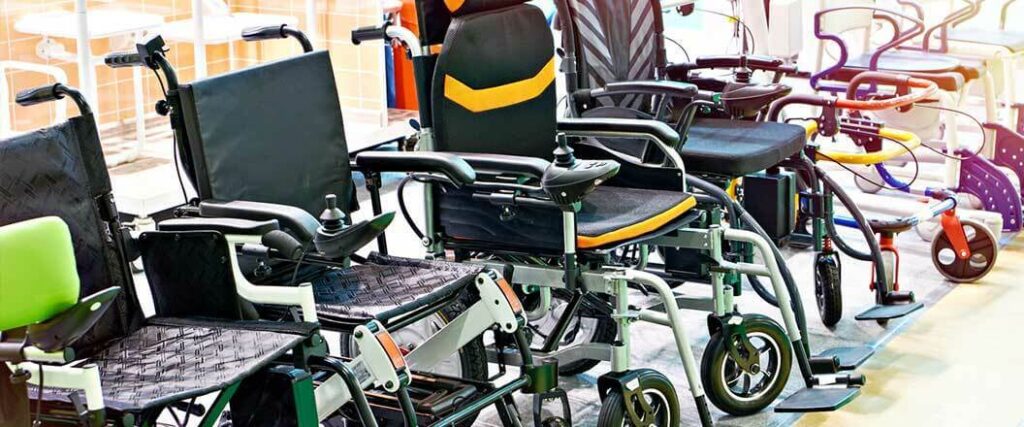Figuring out how to ship a wheelchair might seem straightforward, but there’s actually quite a bit of procedure to follow. Hospitals and other institutions need these essential mobility aids to help people move around. The slightest mistake can cause a wheelchair to become damaged and even unusable upon arrival.
The American Medical Association suggests following these steps when shipping a wheelchair:
These steps will ensure your cargo arrives in working order.
We’ll show you how to ship a wheelchair safely and efficiently so you can help those in need.

Wheelchairs are essential mobility devices that can be easily damaged. That’s why you should prepare your shipment with care to ensure it will survive the journey.
When preparing to ship a bulk load of wheelchairs, selecting the right packing materials is crucial. These items not only ensure the safety of the wheelchairs during transit, but also simplifies the unpacking process at the destination.
Items to obtain should include:
Choose boxes that have a thick exterior. Shippers will need to use boxes that are the right dimensions to ensure the chair will fit snugly. Bubble wrap will be used to protect the wheelchair and fill in any empty spaces.
Packing peanuts or foam pads can be used to fill open areas as well. Strong packing tape will need to be used to secure the boxes holding the wheelchair.
Shippers will need the right labels to properly mark their boxes. These markings signify to carriers the type of cargo that’s being transported.
Due to the fragility of wheelchairs, it’s best to transport bulk loads of these items on a pallet. Therefore, shippers should use these platforms and the correct wrapping to secure the boxed cargo.
Disassembling a wheelchair for shipping is a critical step that will let shippers fit the devices into a box. This might seem difficult to do because of all the parts that make up these mobility devices. Fortunately, a few simple steps can make it quite easy to disassemble a wheelchair.
This includes:
Before starting, it's essential to consult the wheelchair's manual. Each model may have specific instructions or tools required for disassembly. Online manuals can be found if a physical one isn’t available.
Shippers can start removing the detachable parts of a wheelchair, which include:
After removing these parts, shippers will have to secure any loose components. This can be done by using zip ties or Velcro straps to secure movable parts like the leg supports or seatbelt.
Once they’ve been secured, each part should be labeled. This will help the person who has to assemble the wheelchair when it arrives.
Packing the disassembled parts of a wheelchair into a box securely is key to protecting it during shipping. To do this, shippers will need to place their cargo into the box in a specific order.
Use these steps to secure each part of the wheelchair:
Begin by placing the largest parts of the wheelchair in the box. This usually includes the frame and the seat. Putting these parts in first will establish a stable base for the package.
After the larger parts are in place, focus on the smaller components like the armrests, footrests, and wheels. Wrapping these smaller parts individually in bubble wrap will keep them well protected.
With additional cushioning materials, fill in any open spaces remaining to keep the parts from moving while in transit. Layering the parts with cardboard or foam sheets can be used to offer extra protection.
Once all the disassembled wheelchair parts are securely packed into the box, the next step is to close and seal the box properly. This ensures the contents remain secure and protected throughout the shipping process.
Using strong packing tape, seal the flaps on the boxes shut. For extra reinforcement, use tape along the edges and corners of the box.
Once the wheelchairs are disassembled and securely packed into boxes, the next crucial step is placing them on a pallet. Shippers should use a standard 48×40 inch pallet to load their freight on.
If some wheelchairs are heavier than others, the heaviest ones should be placed on the bottom. Based on the dimensions of the boxes, shippers can use a few different stacking methods.
These include:
Use stretch wrap or plastic wrap to bind the boxes to the pallet. Starting at the base of the platform, wrap the load several times. For added stability, use straps to keep the packages in place
Proper labeling will help make sure the load is handled correctly and reaches the final destination without issue.
When labeling the load, follow these steps:
Using clear and legible labels are essential, as it allows carriers to read them easily. Along with the documents required for domestic shipping, the labels must have essential information about their shipment.
This includes:
Each box that makes up a palletized should be marked as fragile. Having this warning will let carriers and receivers know the shipment should be handled with care. If necessary, also include labels that warn against stacking.
With these in place, your shipment will be ready for transport on a straight truck or tractor trailer.

Wheelchairs are essential mobility aids that play a crucial role in the lives of many individuals. Numerous institutions are in constant need of wheelchairs and other medical equipment to provide mobility and independence to their residents, patients, and visitors.
These include:
In the aftermath of the COVID-19 pandemic, medical equipment like wheelchairs and walkers are much harder to come by. Getting repairs for these mobility devices are also extremely difficult. As a result, wheelchairs are in high demand across the country.
The cost of shipping wheelchairs can vary significantly based on several factors. As with most shipments, distance, and fuel costs have a large impact on expenses for transporting these devices.
However, certain factors unique to wheelchair loads include:
For LTL shipments, the freight class of wheelchairs are categorized under will be a determining factor in transport expenses. Rates for these types of loads are influenced by the density, ease of handling, liability, and, stowability of the cargo. Mobility devices that are larger and heavier will be more expensive, while smaller and lighter cargo will cost less.
There is a significant difference between powered chairs and other more standard designs. A customized chair will likely need to be priced individually.

On average, it costs somewhere between $100 and $500 dollars to transport a wheelchair. That said, the price to ship a bulk order will vary whether you use FTL or LTL shipping.
| Distance (miles) | Cost To Ship LTL | Cost To Ship FTL |
| 100 | $325-$450 | $800-$1200 |
| 200 | $550-$675 | $900-$1350 |
| 300 | $775-$900 | $1,000-$1,500 |
| 400 | $1,000-$1,125 | $1,100-$1,650 |
| 500 | $1,225-$1,350 | $1,200-$1,800 |
*based on industry averages
As the data shows, transporting these mobility devices can be very pricey. This is why it’s essential that wheelchairs be packed safely for transport to ensure the shipment is a success.
At USA Truckload Shipping, we understand the intricacies involved in transporting such essential and sensitive equipment. Our expertise in handling special cargo like wheelchairs ensures that your shipment will be managed with the utmost care and professionalism.
Services we offer include:
At USA Truckload Shipping, we are committed to providing top-notch shipping solutions that cater to your unique requirements. Fill out your Request for Proposal (RFP) or call our team at (866) 353-7178 to learn more about the services we provide.
R+L Global Logistics
315 NE 14th St., Ocala, FL 34470
Do you offer shipping outside the continental US? Specifically from CA to HI.